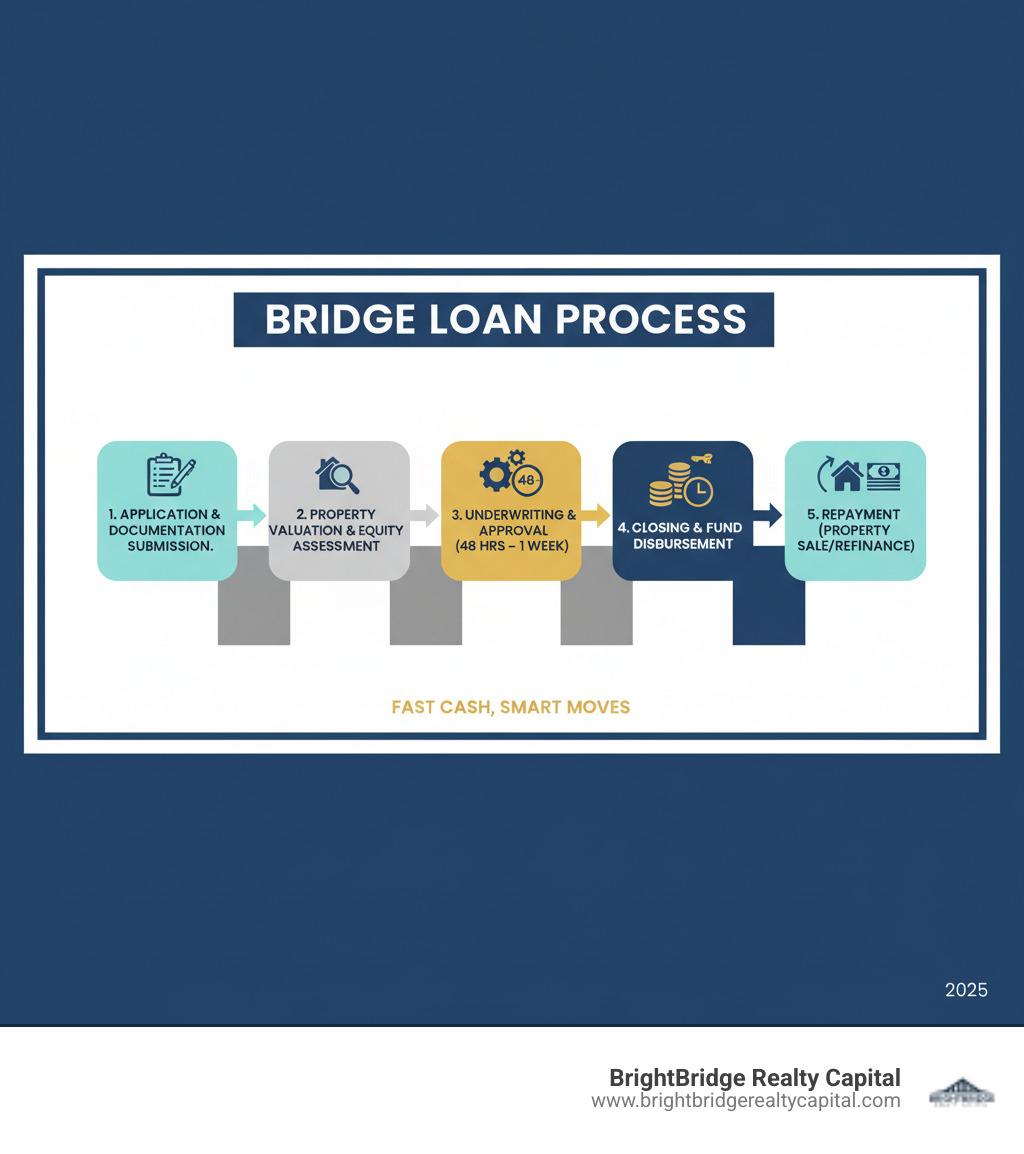Fast Cash, Smart Moves: Securing Your Next Bridge Loan

Why Speed and Flexibility Matter When Choosing a Bridge Loan Provider
A bridge loan provider is far more than just a lender; they are a strategic financial partner, an essential ally for real estate investors and property owners navigating a market where timing is not just important—it is everything. These specialized lenders offer short-term financing that empowers you to act with speed and decisiveness, seizing opportunities that would otherwise be lost in the lengthy and uncertain waiting game of traditional financing. While a conventional bank mortgage is designed for long-term stability, a bridge loan is engineered for immediate impact. Providers in this space specialize in rapid approvals, often turning around applications in a matter of days, from 48 hours to a week, and providing the critical funds secured by the equity in your current or future property. This allows you to close deals quickly, making offers that rival all-cash buyers in their strength and certainty.
Choosing the right provider is a critical decision that can make or break your investment. The core value propositions of a bridge loan are, unequivocally, speed and flexibility. A delay of even a few days in a competitive bidding situation can mean losing a valuable property to a more agile buyer. Similarly, a rigid loan structure that fails to align with your specific exit strategy—whether that's selling an existing property, refinancing a stabilized commercial asset, or completing a fix-and-flip project—can create immense and unnecessary financial strain. A reliable, experienced bridge loan provider understands these pressures intimately and has built their entire operational process around mitigating them. They are not just providing capital; they are providing a tactical advantage in a high-stakes environment.
Key Attributes of a Reliable Bridge Loan Provider:
Fast Closing Times: This is the most significant differentiator. Experienced direct lenders, who use their own capital and have in-house underwriting teams, can often close a loan in 7-10 business days. This stands in stark contrast to traditional banks, which can take anywhere from 45 to 90 days, or even longer. The reasons for this delay are systemic: banks are bound by stringent regulatory requirements (like those established by Dodd-Frank), multi-layered approval committees where a single objection can derail the process, and often-backlogged appraisal and processing departments. A bridge loan provider bypasses this bureaucracy. Their streamlined process focuses on the asset's value, requiring less personal income documentation and allowing for a much faster due diligence and closing timeline. This speed enables you to make non-contingent offers that are nearly as competitive and attractive to sellers as all-cash bids.
Flexible and Customizable Terms: Bridge loans are not one-size-fits-all. They typically have terms of 3 to 12 months, but can sometimes be extended to 24 or 36 months, designed to align with your specific timeline for selling a property, completing renovations, or refinancing. A key element of this flexibility is the payment structure. Many providers offer interest-only payments, which keeps monthly carrying costs low and frees up capital for other needs. An even more powerful option is allowing interest to be rolled into the loan balance through an interest reserve. This means you have no monthly payments at all during the loan term; the accrued interest is simply paid off when the loan is repaid. This is invaluable for value-add projects where the property is not generating income initially. A good provider will work with you to model the best structure, considering factors like prepayment flexibility, which allows you to pay off the loan early without penalty once your exit is achieved.
Multiple Financing Types: The real estate market is diverse, and a versatile provider can fund a wide range of property types, each with its own unique considerations. This includes:
- Residential Properties (1-4 units): For homeowners in transition or fix-and-flip investors who need to acquire and renovate quickly.
- Multifamily Apartment Buildings: For investors looking to purchase, reposition, and stabilize a property before securing long-term agency debt.
- Commercial Properties: Including office, retail, and industrial spaces, often for value-add projects where an investor needs funds for both acquisition and capital improvements.
- Raw Land: For developers who need to secure a prime development site while they finalize plans and obtain permits for construction. Land loans are typically lower leverage (lower LTV) due to their speculative nature.
Higher Interest Rates for Higher Speed: It's crucial to understand the cost structure. Rates for bridge loans are typically higher than conventional loans, often quoted as the prime rate plus a margin (e.g., prime + 2-4%). In addition to the interest rate, borrowers should expect to pay origination points, which are an upfront fee calculated as a percentage of the loan amount (typically 1-3 points). This premium is not arbitrary; it reflects the lender's increased risk, the short-term nature of the loan, and the immense value of speed, convenience, and certainty. For a savvy investor, this higher cost is not a deterrent but a calculated business expense. The short duration of the loan means the total interest paid is often a manageable cost when weighed against the profit potential of securing a time-sensitive deal or the cost of losing it altogether.
Equity-Based Lending: The underwriting philosophy of a bridge loan provider is fundamentally different from a bank's. The approval process focuses primarily on the property's value, not just the borrower's personal credit score and income documentation. Loan amounts are calculated as a percentage of the property's value, known as the Loan-to-Value (LTV), which is typically between 60-75% of the current appraised value. For renovation projects, lenders may use the After-Repair-Value (ARV), lending a percentage of the projected value upon completion of the work. This asset-focused approach is a key reason why approvals are so much faster than with traditional credit-focused lenders. While a borrower's experience and financial standing are still considered, the primary collateral and source of repayment is the real estate itself.
Let's illustrate with a more detailed scenario. Imagine your closing date for a new $1.5 million investment property is in 30 days, but you won't sell your current property (with $800,000 in equity) for another 90 days. That 60-day gap can feel like an eternity when a great deal is on the line. A bridge loan provider can step in and provide a loan of, for example, $1 million against your current property. This loan pays off your existing small mortgage and gives you more than enough cash to close on the new purchase. You capitalize on the opportunity before it vanishes, securing the new asset and giving yourself the breathing room to sell your existing property at its true market value, rather than in a desperate fire sale. The bridge loan is then paid off with the proceeds from that sale.
Finding the right provider means looking beyond the headline interest rate. It means understanding how bridge loans work, what they truly cost, and which lenders offer competitive rates without sacrificing the essential ingredients of speed, service, and reliability. The wrong choice can lead to missed opportunities, unexpected fees that erode your returns, or a stressful, friction-filled process at a time when you need a smooth and seamless transaction.
I'm Daniel Lopez, a loan officer at BrightBridge Realty Capital. As a direct bridge loan provider, we control the entire process in-house, from underwriting to funding. This vertical integration is crucial because it eliminates communication delays, misaligned expectations, and the extra costs often associated with intermediaries or brokers. We focus on fast closings, transparent pricing, and creating customized solutions that fit your unique timeline and investment strategy, helping you succeed in your residential and commercial real estate ventures.

What is a Bridge Loan and When Do You Need One?
Imagine you've found the perfect property—whether it's your dream home in the ideal school district or a promising commercial investment with untapped potential—but there's one critical problem: your capital is tied up in your current property, which hasn't sold yet. You need cash now to make a compelling, non-contingent offer, but your equity is illiquid. This is precisely the scenario where a bridge loan becomes an indispensable tool, acting as a financial "bridge" to span the gap and get you from one property to the next without losing momentum.
A bridge loan is temporary financing that allows you to tap into the equity of your existing property to fund a new purchase. Think of it as a financial stepping stone that keeps you moving forward when the timing of a sale and a purchase doesn't line up perfectly. It is not a different type of mortgage in essence, but rather a mortgage structured specifically for speed and short-term use. The typical duration is anywhere from 90 days to 12 months, though some can extend up to three years for more complex projects. Bridge loans can be structured as "closed," with a fixed, predetermined repayment date, which is ideal when you already have a buyer and a closing date for your current property. Alternatively, they can be "open," offering more flexibility if you don't have a firm sale date, though this flexibility may come at a slightly higher cost. The beauty of working with a dedicated bridge loan provider is the velocity. You're not waiting weeks or months for a traditional mortgage approval that scrutinizes every detail of your financial life. Instead, you're accessing funds with incredible speed—often within a week—so you can close on that new property before another buyer snatches it up.

Here's how bridge loans stack up against traditional mortgages in more detail:
| Feature | Bridge Loan | Traditional Mortgage |
|---|---|---|
| Term Length | 3-12 months (sometimes up to 3 years) | 15-30 years |
| Approval Speed | 48 hours to 1 week | 30-60+ days |
| Interest Rate | Higher (prime + 2-4%) | Lower (fixed or variable market rates) |
| Underwriting Focus | Property equity and value (asset-based) | Borrower's credit, income, and DTI |
| Primary Purpose | Short-term gap financing, quick acquisitions | Long-term home ownership, primary residence purchase |
| Fees | Origination points (1-3%) + processing | Standard closing costs, lower points |
| Documentation | Simplified; focused on asset (appraisal, title) | Extensive; focused on borrower (tax returns, pay stubs) |
| Lender Type | Direct private lenders, hard money lenders | Banks, credit unions, mortgage companies |
| Best For | Time-sensitive deals, non-contingent offers | Standard property purchases with no time pressure |
The trade-off is straightforward and transparent: you pay a premium in interest and points for the unparalleled convenience of speed, flexibility, and certainty. But when you're competing in a hot real estate market, trying to win a property at auction, or attempting to lock in a time-sensitive deal, that speed can make all the difference, turning a potential loss into a profitable win.
Common Scenarios for Residential Bridge Loans
Homeowners transitioning between properties are the most common users of residential bridge loans. In a competitive real estate market, sellers overwhelmingly favor offers without sale contingencies. A contingency clause makes your offer dependent on selling your current home, which introduces uncertainty and delay for the seller. A bridge loan eliminates this problem, empowering you to make a clean, strong offer because you have the funds ready to go. This can be the single deciding factor that gets your offer accepted over others, preventing you from watching someone else move into your dream home. Many homeowners also use bridge loans to fund renovations before moving in. If your new property needs significant work to be livable, a bridge loan can be structured to cover both the purchase price and the initial repair costs. This allows you to complete the project while you comfortably prepare your current home for sale, maximizing its appeal and sale price.
Another key use case is avoiding a fire sale. Without a bridge loan, a homeowner who has already committed to a new purchase might feel pressured to accept a lowball offer on their current home to meet the closing deadline. This desperation can cost tens of thousands of dollars. A bridge loan provides the financial cushion and breathing room to wait for the right offer, ensuring you sell your property for its true market value.
Bridge Loans for Commercial and Business Use
Bridge loans are an indispensable tool for savvy commercial real estate investors. They are constantly used for time-sensitive acquisitions, especially when competing against all-cash buyers or securing an off-market deal before it's widely advertised. A crucial and frequent use case is for 1031 exchanges. In a 1031 exchange, an investor has a strict 45-day window from the sale of their old property to identify a replacement property and a total of 180 days to close on it to defer capital gains taxes. If the sale of the old property is unexpectedly delayed, it can jeopardize the entire exchange. A bridge loan can secure the new property within the required timeline, ensuring the exchange is successful and saving the investor from a potentially massive tax liability.
Value-add projects are another perfect fit. Consider an investor who identifies a poorly managed commercial property with high vacancy and deferred maintenance. A bridge loan provides the capital to both acquire the asset and fund the necessary renovations, rebranding, and marketing to attract new, higher-paying tenants. Once the property is stabilized with strong cash flow and higher occupancy, its value increases significantly. The investor can then refinance with traditional, long-term commercial financing at a lower interest rate, pay off the bridge loan, and realize a substantial profit from the increased equity. This entire strategy is predicated on the ability to access fast, flexible capital upfront, which is exactly what a bridge loan provides.
Beyond real estate, some businesses use bridge loans for critical cash flow management. A company might use a bridge loan secured by its owned real estate to cover payroll, purchase inventory for a large order, or fund other operational expenses while waiting for a large contract payment or permanent financing (like an SBA loan) to close. It's a short-term solution that keeps operations running smoothly and enables growth that would otherwise be stalled by a temporary lack of liquidity.
If you're planning a ground-up development, you might want to explore commercial construction financing solutions that are specifically structured for new builds, as they handle fund disbursement in draws according to a construction schedule, which is different from typical bridge financing.
The bottom line is this: bridge loans work when speed is paramount and you have equity to leverage. The most critical component for any borrower is having a clear and viable exit strategy—a plan for how the loan will be repaid. Whether it's the sale of a property, a long-term refinance, or incoming revenue, a good bridge loan provider will work with you to ensure your exit plan is sound. Whether you're a homeowner making a strategic move or an investor seizing a fleeting opportunity, the right bridge loan provider can help you close the gap between where you are and where you need to be.


